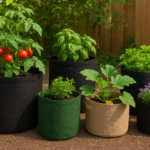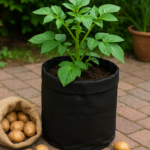How to hang plants from the ceiling without drilling? Hang plants from the ceiling without drilling is a fun way to save space using adhesive hooks or tension rods. Magnetic hooks are an option for metal ceilings.
Hanging plants elevate interior design, creating a lush, vibrant ambiance in any room. Many plant enthusiasts shy away from ceiling mounts for fear of damaging their ceilings with drill holes.
There’s a range of non-invasive methods available, such as adhesive hooks that stick to the surface and can hold lightweight plants.
Magnetic hooks offer a sturdy and movable hanging point for rooms with metal ceilings or fixtures. These techniques provide a neat solution for renters or homeowners who value flexibility in their decor while preserving the integrity of their ceiling surfaces.
Can You Hang Plants From A Ceiling Without Drilling?

Imagine transforming your room into a lush garden oasis without picking up a drill. It’s possible to hang plants from the ceiling without drilling, keeping your landlord happy and your deposit safe. This guide will explore innovative ways for plant lovers to suspend their greenery, creating an indoor jungle that doesn’t leave a single mark.
Utilizing Adhesive Ceiling Hooks
Adhesive ceiling hooks provide a versatile and damage-free solution for hanging plants without drilling. They offer a practical and efficient way to hang plants in various areas of your home. With adhesive ceiling hooks, you can display plants without the need for drilling or hardware. These hooks are lightweight, durable, and ideal for adding greenery throughout your living space.
Tension Rod
Tension rods offer a versatile and adjustable solution for hanging plants without drilling, providing a secure and flexible option for various spaces. They allow you to create unique and adjustable plant displays, offering a practical and durable method for hanging plants without causing wall damage.
When two walls are close enough, a tension rod with rubber tips can be mounted almost to ceiling height. Tension rods are a simple and adaptable alternative for creating a beautiful indoor garden.
The length of a standard shower tension rod ranges from 41 inches to 72 inches. The weight capacity of each product varies but ranges between 10 and 30 pounds. Curtain tension rods can extend to 120 or even 160 inches. That’s a full 10 to 13 feet, or long enough to span a small room.
Command Hooks
Command Hooks offers an ideal solution for hanging lightweight plants on walls or ceilings, with a weight limit of 5 pounds. The versatility of Command Hooks in various sizes, shapes, and colors allows customization to match the space. Their popularity stems from being safe on walls due to removable adhesive hooks, making them suitable for those who change their decor. The option of brushed nickel Command Hooks is highlighted for both practicality and style.
Tension Rods
Metal tension rods, extending from wall to wall, provide the illusion of ceiling-hung plants without actual ceiling attachment. These rods can be mounted in spaces like wall gaps, skylight frames, or hall ends using non-marring rubber-tipped rods. Standard shower tension rods range from 41 to 72 inches, with weight capacities varying from 10 to 30 pounds. Extra-long tension rods, extending up to 120 or 160 inches, are suitable for larger spans.
Tension rods provide a secure and flexible option for hanging plants in different areas of your home and allow for easy change of height and placement. With their durability and practicality, tension rods are a lightweight and versatile method for hanging plants without causing any wall damage.
Magnetic Plant Hooks
Magnetic plant hooks provide a secure, stylish, and practical solution for hanging plants without drilling. Their strong magnet offers a durable and damage-free way to display plants in various locations. These hooks can create a unique and decorative display while ensuring the plants are placed.
A three-pack of magnetic hooks, capable of holding weights ranging from 11 to 27 pounds, making them suitable for even heavy plants, is highlighted. This makes them an attractive option for interior designers and homeowners who want to add green decorations to their spaces.
Adhesive Utility Hooks
Adhesive utility hooks are like adhesive ceiling hooks but are designed to withstand more weight. These are an excellent choice for hanging heavier plant pots. It’s important to check the weight capacity before hanging your plant to ensure the safety of your green sanctuary.
Suction Cup Hooks
Suction cup hooks provide an effective method for hanging plants from the ceiling, but they are limited to smooth, non-porous surfaces. Skylights and sturdy surfaces made of glass or plastic are suitable candidates for these hooks. While weight capacities are low, around a pound, some suction cup hooks claim capacities of up to 10 pounds.
Ideal for glass or glossy tiles, suction cup hooks offer an easy and temporary solution for your hanging plants. These hooks are easy to install and remove without leaving any marks, making them perfect for temporary setups or seasonal decorations.
Bar Clamps
To hang plants near the ceiling without drilling, a carpenter’s bar clamp offers a unique and eye-catching solution. These clamps have an adjustable jaw on a metal rail, with lengths of up to 36 or 48 inches. The design allows a bar clamp to grasp the 4-inch width of an end wall, providing a cantilevered bar for holding lightweight plants at its end. This approach is adaptable and eliminates the need for any modifications to your ceiling.
C-clamps
If you have exposed beams, pipes, or railings, C-clamps can be an unconventional yet effective method to hang plants. These C-clamps can grasp both sides of the beam and support considerable weight, holding plants up to 50 pounds. The choice between a 6- or 8-inch C-clamp depends on the beam’s width. To prevent indentation marks on the beam, it’s advised to use separate clamp jaw pads or thick rubber squares.
Pros and Cons of No-Drill Hanging Methods
Hanging plants without drilling can be a great way to add greenery to your space without causing damage to your walls or ceiling. However, like any method, it has its pros and cons.
Pros
- No Damage to Walls or Ceiling
- No-drill hanging methods offer a lot of versatility.
- Easy Installation and Removal
Cons
- No-drill hanging methods often have weight limitations.
- Limited Options for Heavy Plants
Choosing the Right Plants for Hanging

Choose lightweight plants such as pothos or spider plants when hanging plants without drilling. These species thrive when suspended due to their low-maintenance nature. Consider using adhesive hooks for philodendron, pothos, and spider plants, while magnetic hooks work well for plants like philodendron when hanging from metal beams. Additionally, hanging planters are suitable for indoor plants that need direct sunlight.
Plant Species that Thrive when Hanging
Spider plants, philodendrons, and pothos are excellent choices for hanging plants due to their low-maintenance nature. Devil’s ivy, also known as pothos, adapts well to different light conditions, thriving when suspended. With its unique cascading foliage, spider plants are suitable for hanging, while philodendron’s trailing vines make it a great candidate for no-drill methods. These plants can be hung using trellis, macrame hangers, or plant pots with built-in hangers.
How to Care for Hanging Plants
Water your hanging plants based on their moisture needs, ensuring proper drainage to prevent water accumulation. Place them in locations that best suit their light exposure requirements and rotate them for even growth. Prune as needed to maintain shape, remove dead foliage, and encourage healthy growth. Additionally, feed your hanging plants with a balanced fertilizer following plant-specific guidelines for optimal nourishment.
Safety Considerations
- Weight Limits: Always respect the weight limits of the hanging solutions you choose. Overloading can lead to accidents, causing damage to your property or injury to people and pets.
- Secure Installation: Ensure that your chosen hanging method is secure. Inspect the hooks, rods, or tension rods for stability to prevent accidents.
- Location: Avoid hanging plants above-head or above fragile objects since plants can fall when using non-drilling methods. Also, do not hang plants from light fixtures, lighting tracks, fire sprinklers, smoke alarms, or security cameras.
- Ceiling Strength: The hanging hardware and plants should be at most the weight of the ceiling. Using heavy-duty anchors or ceiling hooks might be a better option if you’re in doubt.
- Adhesive Quality: The manufacturer’s instructions should be followed when installing high-quality adhesive hooks. Make sure the hooks remain secure by checking them.
- Plant Care: Proper watering, pruning, and occasional repositioning are essential for their well-being. If your hanging planters have drainage holes, consider using drip trays to catch excess water and prevent it from dripping onto your floor or furniture.
- Choice of Plants: Opt for lightweight and compact varieties that thrive in moderate to low light if you’re new to hanging plants
- Choice of Hanging Method: There are several methods to hang plants without drilling, including tension rods, magnetic plant hooks, adhesive hooks, and clamps. Each method has its weight limit and suitability for different types of surfaces, so choose.
Best Lightweight Plants For Hanging Without Drilling
Several lightweight plants are ideal for hanging without drilling. These include:
- Lucky Bamboo (Dracaena sanderiana)
- Philodendron wend imbe
- Basil
- Peace Lily
- Umbrella Plant
- Anthurium andraeanum
- Pothos
- Monstera deliciosa
- Spanish Moss
- Air Plants (Tillandsias)
- English Ivy
- Boston Fern
7 Extra Ideas for Hanging Plants Without Drilling Holes
- Window Sill Ledges: If you have wide window sills, you can place small potted plants on them. This not only saves space but also provides the plants with ample sunlight.
- Shower Rods: If you have a bathroom with a window that lets in light, you can hang plants from the shower rod. This is especially suitable for plants that thrive in humid conditions.
- Wall Magnets: If your walls are made of a material that attracts magnets, you can use magnetic hooks to hang your plants
- Plant Ladders: These are free-standing structures that have several tiers where you can place your plants. They don’t need any drilling and can hold many plants.
- Floating Shelves: These shelves are attached to the wall using adhesive. They can hold lightweight plants and don’t need any drilling.
- Curtain Rods: You can hang lightweight plants from curtain rods using S-hooks. This is especially useful if you have a window that gets a lot of sunlight.
- Furniture: You can place plants on top of tall pieces of furniture like bookshelves or cabinets. Using this method, hanging plants can be created without drilling.
Frequently Asked Questions For How To Hang Plants From Ceiling Without Drilling
How Do You Hang A Plant From The Ceiling Without It Falling?
To hang a plant from the ceiling, choose a location with a ceiling joist for support. Use a stud finder to locate the joist. Then, screw a hook into the joist. Ensure the hook can support the plant’s weight, and hang the plant on the hook.
Can You Hang Plants From Ceiling With Command Hooks?
Yes, you can hang plants from the ceiling using command hooks, but ensure they are rated for the plant’s weight.
How Do You Hang Things From The Ceiling In A Rental?
To hang items from the ceiling in a rental, use adhesive hooks designed for temporary placement and damage-free removal. Check the weight capacity to ensure safety. Opt for magnetic systems if you have a metal ceiling. Always consult your landlord or rental agreement before making any modifications.
How Do You Hang Plants On The Wall Without Screws?
- Use adhesive strips or hooks that stick to the wall. Make sure they can bear the plant’s weight.
- Opt for magnetic plant holders if you have a metal surface available.
- Wall-mounted plant stands can cradle your greenery.
- Suction cup shelves work wonders on glass windows or mirrors.
Install a grid panel or trellis against the wall for a meshwork that can host many plants.
How Do You Hang A Plant In A Rental?
Choose removable hooks that don’t damage walls to hang plants in a rental. Use tension rods or standing plant holders for a non-permanent solution. Always check your lease agreement for any restrictions before making alterations.
What Are the Best Ways to Hang Plants From the Ceiling?
Explore versatile options like suction cup hangers for lightweight plants. Tension rods provide security and adjustability. Consider ceiling hooks for reliable support. Spring curtain rods accommodate various plant hanger sizes. Door hooks offer a convenient, no-drill solution for hanging plants as interior decor accents.
Is it Possible to Hang All Types of Plants Without Drilling?
Yes, it is possible to hang all types of plants without drilling. Lightweight plants like spider plants and pothos can be hung using adhesive hooks. For plants like philodendron that require metal beams, magnetic hooks provide a versatile hanging option.
Conclusion
With adhesive hooks, magnetic hangers, and tension rods, your ceilings can stay intact while your plants flourish. It emphasizes the importance of selecting suitable plants for hanging, installing hanging hardware, and providing proper care for the plants to thrive in their elevated spaces. The result is a tranquil and charming indoor oasis, showcasing the beauty of nature while preserving the integrity of the living space. The readers are encouraged to enjoy hanging plants and gardening with the provided techniques.
You may also like small plant stand indoors







